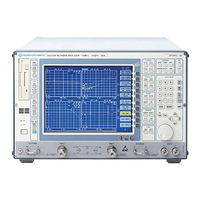User Manuals: Rohde & Schwarz ZVRL Network Analyzer
Manuals and User Guides for Rohde & Schwarz ZVRL Network Analyzer. We have 1 Rohde & Schwarz ZVRL Network Analyzer manual available for free PDF download: Operating Manual
Rohde & Schwarz ZVRL Operating Manual (1017 pages)
VECTOR NETWORK
ANALYZER
Brand: Rohde & Schwarz
|
Category: Test Equipment
|
Size: 6 MB
Table of Contents
-
-
-
New Features13
-
Improvements14
-
-
3 Bug Fixes
15
-
-
-
Introduction76
-
-
Start-Up95
-
Firmware Update112
-
Options114
-
Operation117
-
Operation123
-
-
-
-
Menu Overview154
-
SYSTEM Key Group154
-
COPY Key Group158
-
MEMORY Key Group159
-
USER Key161
-
SWEEP Key Group162
-
MARKER Key Group164
-
LINES Key Group166
-
CAL Key Group170
-
Screen177
-
-
The Diagram Area178
-
The Softkey Area188
-
Single Channel189
-
Diagrams193
-
-
-
Polar Diagrams197
-
-
-
Smith Charts200
-
-
-
Display Windows202
-
Message Fields202
-
System Messages205
-
-
-
-
Nd and261
-
Sweep Modes267
-
-
System Messages282
-
-
Fundamentals314
-
Starting Macros315
-
Defining Macros316
-
-
-
-
Remote Control
507-
Introduction
542 -
Remote Control
542 -
-
Messages
547 -
-
Notation555
-
Common Commands558
-
Format Subsystem593
-
Hcopy Subsystem596
-
Input Subsystem603
-
-
-
-
SYSTEM Key Group701
-
COPY Key Group707
-
MEMORY Key Group708
-
STATUS Key Group710
-
SWEEP Key Group711
-
MARKER Key Group714
-
-
Maintenance
730 -
-
-
Test Set732
-
Converter733
-
Front End733
-
Synthesizer733
-
Local734
-
Output Stage734
-
Source734
-
-
-
Self Test
736 -
-
-
Phase Noise741
-
Level Accuracy742
-
Residual FM742
-
Level Linearity743
-
-
Linearity746
-
Noise Level747
-
-
Directivity751
-
Crosstalk753
-
-
-
-
Phase Noise781
-
Level Accuracy782
-
Residual FM782
-
Level Linearity783
-
-
Linearity786
-
Noise Level787
-
-
Directivity790
-
Crosstalk792
-
-
-
-
-
Harmonics826
-
Spurious827
-
Phase Noise828
-
Residual FM829
-
Level Accuracy830
-
Level Linearity831
-
-
Linearity833
-
Noise Level834
-
-
Advertisement
